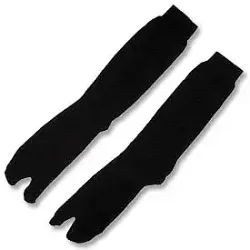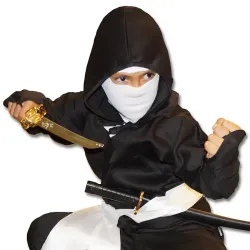The Untold History of Female Ninjas: Secrets of the Kunoichi
August 29th, 2025

When most people think of ninjas, the image that comes to mind is a shadowy figure dressed in black, slipping silently across rooftops under the cover of night. What many don't realize is that women also played an important part in Japan's ninja history. These female ninjas, known as kunoichi, were trained in espionage, infiltration, and combat, and they became some of the most effective operatives of their time. While the records are fewer and less detailed than those about male ninjas, the legacy of female ninjas is fascinating, and their influence is still felt in martial arts and pop culture today.
Who Were the Kunoichi?
The word "kunoichi" is often translated as "female ninja," but the role wasn't just about fighting with swords or throwing stars. Kunoichi were experts in deception and survival, and they frequently used their ability to blend into everyday society as their greatest weapon. Unlike male ninjas, who were more likely to operate in plain combat gear, female ninjas were often disguised as entertainers, shrine maidens, servants, or even housewives. These roles gave them access to places that would have been closed off to men, making them valuable spies and infiltrators.
Historical texts suggest that kunoichi were trained in the same core skills as male ninjas: martial arts, stealth, weapon use, and survival tactics. But they were also instructed in skills that took advantage of gender roles at the time. They could gain the trust of samurai households, gather information, and even carry out assassinations when needed.
The Most Famous Female Ninja
One of the most well-known figures in kunoichi history is Mochizuki Chiyome, a noblewoman from the Sengoku period (1500s). According to legend, she was tasked by a warlord named Takeda Shingen to create a network of female operatives. Chiyome recruited women from difficult circumstances such as orphans, outcasts, and widows, and trained them to act as shrine maidens, traveling performers, or servants. In reality, they were spies who fed intelligence back to her clan.
Whether all of these stories are historically accurate is debated by scholars, but the idea of an organized female ninja network captures the imagination. Even if some of the details have been embellished, there's no doubt that women like Chiyome played an important role in shaping the tactics of espionage in feudal Japan.
How Female Ninjas Fought
When people picture a female ninja uniform today, they might imagine the same black gi worn by male ninjas, just in a different cut. But historically, kunoichi didn't always wear a standard ninja outfit. Their clothing often depended on the mission. If they were infiltrating a household, they might dress as a servant. If they were moving through towns, they could disguise themselves as entertainers or merchants. The ability to blend in was more important than looking like the stereotypical ninja.
That said, when training or fighting directly, kunoichi would have worn functional martial arts clothing similar to the ninja gi we recognize today. Practical, durable, and designed for free movement, it was the same type of gear that has inspired the modern ninja uniforms you'll find on KarateMart.
Weapons used by female ninjas were often easy to conceal. They favored small blades, hairpins sharpened into daggers, and powders or poisons that could be slipped into food or drink. While male ninjas might have relied more heavily on swords, throwing stars, or chain weapons, kunoichi adapted their arsenals to tools that wouldn't draw suspicion until it was too late.
Strategy and Espionage
What made female ninjas so dangerous wasn't just their ability to fight, but their ability to deceive. A kunoichi might gain entry into an enemy's household by posing as a maid, only to gather intelligence from overheard conversations. Others could act as entertainers at gatherings, where alcohol loosened tongues and secrets spilled easily. In extreme cases, they used seduction to get close to their targets.
Because they were underestimated by the men around them, kunoichi often had the advantage of surprise. Their strength lay in using society's expectations against it. While samurai might have expected an attack from a fellow warrior, they were less prepared for a strike from someone they saw as harmless.
Female Ninjas in Pop Culture
Over time, the image of the female ninja has grown into something larger than history alone. Movies, anime, and video games often portray kunoichi as skilled martial artists with flashy moves and iconic outfits. While the reality was often more subtle and practical, pop culture has helped keep the memory of female ninjas alive. Characters in Japanese media frequently draw inspiration from the legends of women like Mochizuki Chiyome, blending history with fantasy.
In modern martial arts and costuming, female ninja uniforms have become a popular way to connect with this tradition. Whether it's for Halloween, cosplay, or training, there's something powerful about putting on a ninja gi and tapping into that sense of stealth and strategy. The rise of unique styles, like pink ninja gis or girls ninja costumes, shows how the legacy of the kunoichi continues to inspire new generations.
The Legacy of the Kunoichi
Although female ninjas may not have been written about as often as male ninjas, their impact shouldn't be underestimated. They were resourceful, clever, and capable of turning cultural expectations into weapons. In a time when women were often dismissed as powerless, the kunoichi used that very perception to their advantage, carving out a role in one of the most secretive and fascinating traditions in Japanese history.
Today, the idea of the kunoichi lives on not only in books and entertainment but also in martial arts practice and costume culture. Whether you're studying ninjutsu or putting together a female ninja costume for an event, you're tapping into a tradition that goes back hundreds of years.
Final Thoughts
Female ninjas might not be as well documented as their male counterparts, but the stories we do have reveal a lot about the creativity and adaptability of women in ancient Japan. The kunoichi remind us that ninjutsu wasn't just about brute force or flashy weapons. It was about strategy, patience, and using whatever tools were available to get the job done.
You May Also Be Interested In:
- A Brief History of Kung Fu
- A Brief History of Judo
- From Jungle Tool to Movie Legend: The History of the Machete
- History of the Baton: From Police Nightstick to Self-Defense Tool
- The History of the Kendo Uniform: From Samurai Armor to Modern Training
- Brass Knuckles Explained: History, Design, and Modern Laws
- The History of the Karambit: From Indonesian Farm Tool to Modern Tactical Icon
- The Ultimate Guide to Butterfly Knives: History, Safety & Flipping Tips
- The Real History of Nunchaku: From Farm Tool to Martial Arts Icon
1 Comment(s)
"Yagen
Used by kunoichi"
Written By: Te
9/20/25 - 3:33am
Leave a Reply






 (10)
(10)

































